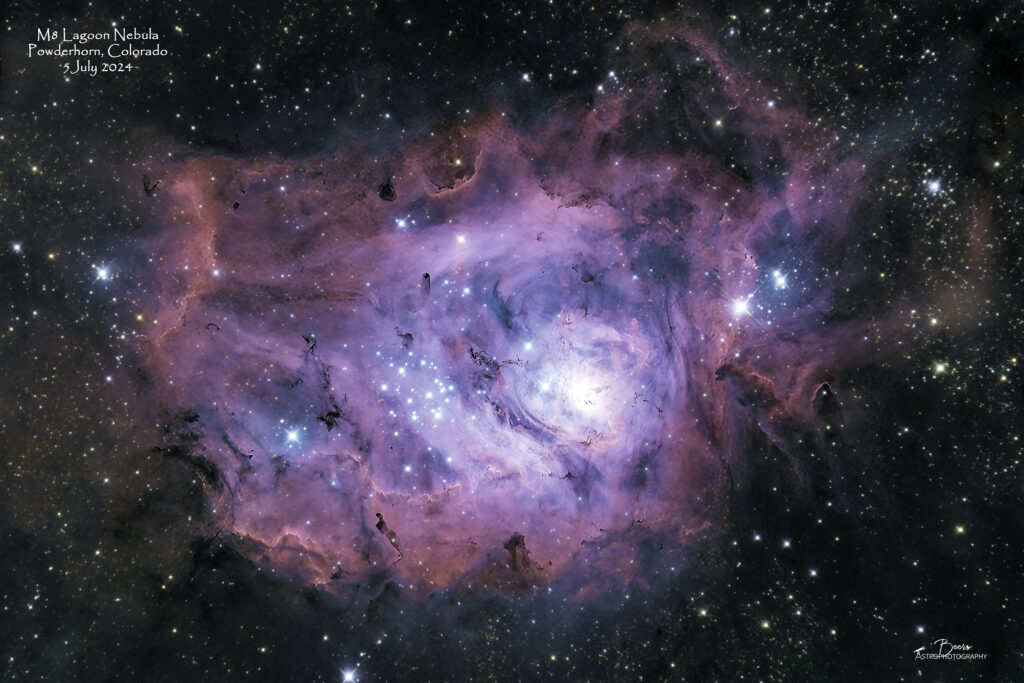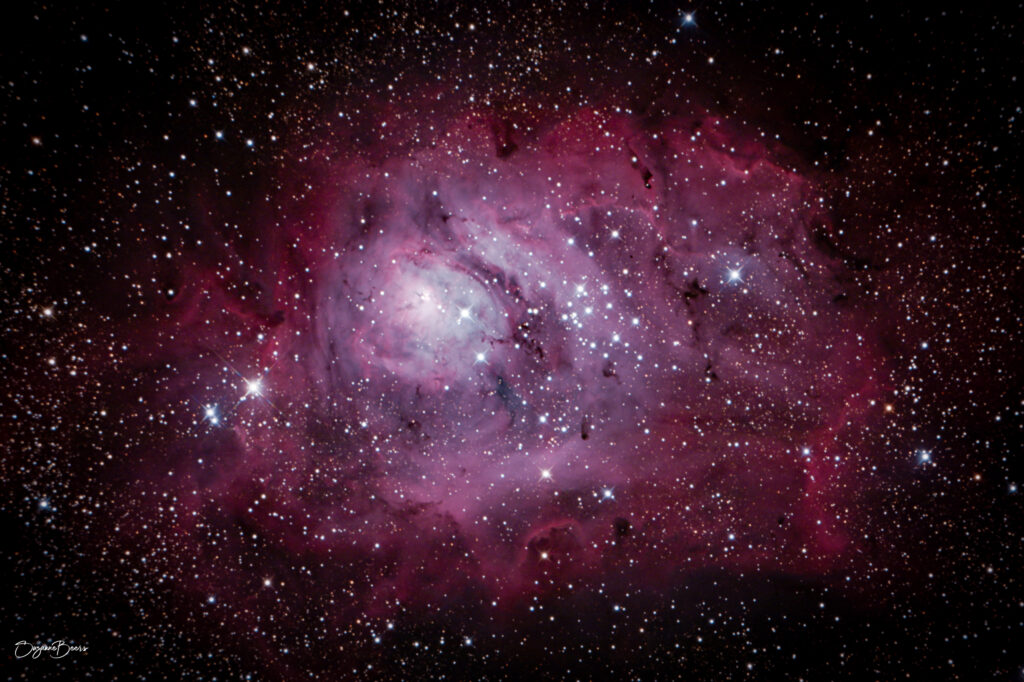
Target Fun Facts
The Lagoon Nebula is a giant interstellar cloud in the constellation Sagittarius. It is classified as an emission nebula and as an H II region. M8 Lagoon Nebula was discovered by Giovanni Hodierna before 1654 and is one of only two star-forming nebulae faintly visible to the eye from mid-northern latitudes.
The Lagoon Nebula is estimated to be between 4,000–6,000 light-years away from the Earth. In the sky of Earth, it spans 90′ by 40′, which translates to an actual dimension of 110 by 50 light years. Like many nebulae, it appears pink in time-exposure color photos but is gray to the eye peering through binoculars or a telescope, human vision having poor color sensitivity at low light levels. The nebula contains a number of Bok globules (dark, collapsing clouds of protostellar material), the most prominent of which have been catalogued by E. E. Barnard as B88, B89 and B296. It also includes a funnel-like or tornado-like structure caused by a hot O-type star that emanates ultraviolet light, heating and ionizing gases on the surface of the nebula. The Lagoon Nebula also contains at its center a structure known as the Hourglass Nebula (so named by John Herschel), which should not be confused with the better known Engraved Hourglass Nebula in the constellation of Musca. In 2006, four Herbig–Haro objects were detected within the Hourglass, providing direct evidence of active star formation by accretion within it.
Other Catalog Designations: M8, NGC 6523, Sharpless 25, RCW 146, and Gum 72
Subtype: Emission Nebula
Distance from Earth: 4077 light years
Visual Magnitude: 6.0
Constellation: Sagittarius
{ From: https://en.wikipedia.org/wiki/Lagoon_Nebula and Stellarium }
Capture Notes
This image was captured on the second night of our July 2024 dark skies camping trip on BLM land near Powderhorn, Colorado. During the day, I attached the ZWO EAF autofocuer to Big Bertha (I decided not to attach it on the first night since I was running low on time before sunset – arriving and setting up camp, the Southern Cross, and then Big Bertha took all the daylight hours) and set the focuser settings in SGP to the same (changed) settings I had established for the Southern Cross (7 data points, 75 steps). I selected targets for the night: SH2-126 Gecko Nebula for the Southern Cross; M8 Lagoon Nebula and NGC7380 Wizard Nebula for Big Bertha. Once darkness began to fall, I got Big Bertha started first, since she was going to image two targets to SC’s one. I did the polar alignment (close to the previous night’s for BB, almost unnecessary for SC!), connected cables, and got BB started on imaging M8.
The EAF kept failing – the delta between the first two data points was very steep and then the remaining points were essentially on a straight line. SGP’s algorithm selected 17960 as the optimal focus point, but would only ever give it a quality score of ~82% – so SGP would never resolve the focusing. I selected cancel and it went ahead with the plate solving and calibrating PHD2. After the calibration, it went back to the autofocus routine and again failed, I selected “cancel” after the first failure and it returned the focuser to the starting point and began the sequence. At that point, I gave up on the autofocuser, going into SGP and changing the tool setting to uncheck “use auto focus.” The individual subframes looked great, so decided to continue with my plan of changing targets at M8’s meridian flip (~0035) to the Wizard Nebula for the rest of the night.
Equipment
Equipment: All equipment controlled by HP Probook running Sequence Generator Pro v4.4.0.1339.
- Imaging (ASI2400-BB): ZWO ASI2400MC imaging camera on (Big Bertha) Orion 8″ f/8 Ritchey-Chretien Astrograph Telescope
- Autofocuser: ZWO EAF Electronic Automatic Focuser – Standard (EAF-5V-STD)
- Mount: Rainbow Astro RST-135E (controlled by iHubo ASCOM driver)
- Polar alignment: QHYCCD camera (controlled by Polemaster for polar alignment)
- Autoguiding: Orion 60mm Multi-Use Guide Scope with Orion StarShoot AutoGuider Pro Mono Astrophotography Camera (controlled by PHD2)
Capture & Processing Notes
Sequence Plan: Gain: 158, Temp: -0°C, offset=30. 30x5min. Captured 5Jul2024, 2154 – 6Jul2024, 0030MDT. Total exposure time: 2:30hrs (150min, ASI2400-BB)
Capture Date: 5 July 2024
Location: BLM land near Powderhorn, Colorado
Additional image of M8 Lagoon Nebula

Capture Notes
This image was taken during my first fully successful night of imaging after struggling with the Canon EOS Ra consistently connecting to my laptop and AP control software for almost six months. During that trip to Rocky Reservoir in the far northwest corner of Colorado, I had two nights (9-10 July 2021) of gloriously clear and dark skies and fully successful imaging. I imaged M8 Lagoon Nebula, M16 Eagle Nebula, and NGC6960 Witch’s Broom from the Veil Nebula. I was still imaging with ISO800 at that point, afraid of the noise that might be induced with higher exposures – but this target was bright enough to shine through that rookie’s judgment call.
Equipment
Polar alignment: QHYCCD camera (controlled by Polemaster)
Imaging stream: Orion 8″ f/8 Ritchey-Chretien Astrograph Telescope, Canon EOS Ra
Mount: Sky-Watcher EQ6-R Pro Equatorial Mount (controlled by EQMOD)
Autoguider: Orion 60mm Multi-Use Guide Scope, Orion StarShoot AutoGuider Pro Mono Astrophotography Camera (controlled by PHD2)
All equipment controlled by HP Probook running Sequence Generator Pro v3.2.0.660.
Capture & Processing Notes:
Sequence Plan: ISO800; 50x180sec. Total exposure time: 2:30hrs. Captured 10Jul2021, 0136 – 0414MDT. Capture Date: 10 July 2021
Shooting Location: Rocky Reservoir, Colorado
